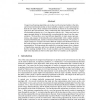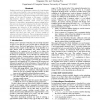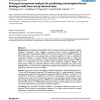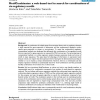962 search results - page 97 / 193 » Redundancy based feature selection for microarray data |
NIPS
2007
14 years 11 months ago
2007
Unsupervised learning algorithms aim to discover the structure hidden in the data, and to learn representations that are more suitable as input to a supervised machine than the ra...
ICPR
2006
IEEE
15 years 11 months ago
2006
IEEE
Finding a small set of representative instances for large datasets can bring various benefits to data mining practitioners so they can (1) build a learner superior to the one cons...
128
click to vote
BMCBI
2005
14 years 9 months ago
2005
Background: The responses to interleukin 1 (IL-1) in human chondrocytes constitute a complex regulatory mechanism, where multiple transcription factors interact combinatorially to...
BMCBI
2007
14 years 10 months ago
2007
Background: A combination of multiple types of transcription factors and cis-regulatory elements is often required for gene expression in eukaryotes, and the combinatorial regulat...
155
click to vote
ISNN
2011
Springer
14 years 23 days ago
2011
Springer
This paper presents a new method that uses orthogonalized features for time series clustering and classification. To cluster or classify time series data, either original data or...




